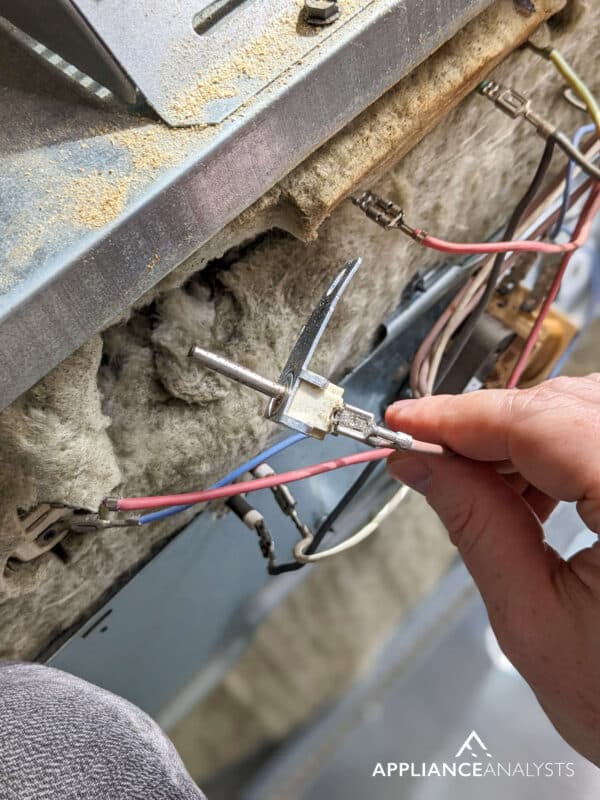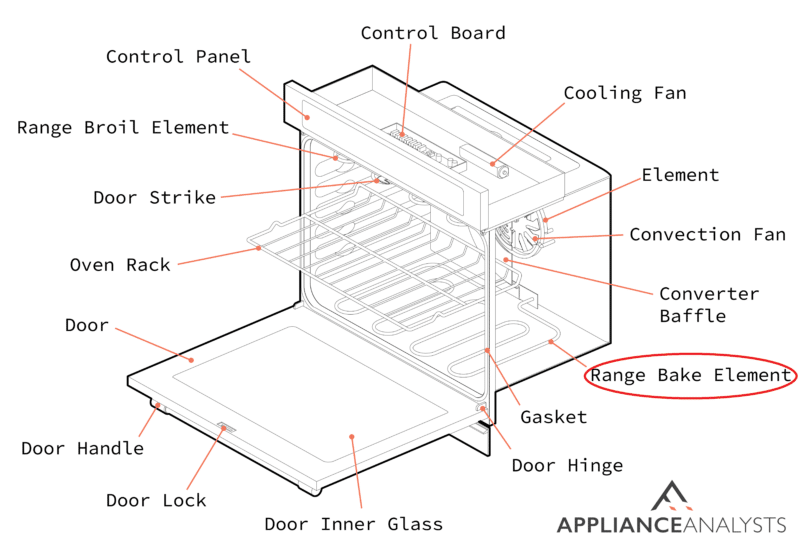Are you stuck trying to figure out why your oven isn’t working?
You’re not alone! In fact, broken-down ovens affect a large number of people all around the world each day.
But the good news is that you’ve come to the right place for answers.
If your oven isn’t working, there’s a good chance you have a faulty burner, socket, or igniter switch. A damaged temperature sensor, a dirty burner or gasket, or a broken door could also explain the issue.
Keep reading to get your oven back to normal!
5 Reasons Why Your Oven Isn’t Working (With Fixes)
There’s nothing more annoying than wanting to cook a delicious meal only to find that your oven is not working correctly.
There are many symptoms your oven could be showing that can make you think it’s not working. Here are the 5 most common issues I encounter:
#1 The Range Burner Is Not Heating
Like an electric stove, an electric oven needs a range burner that turns on. There are situations where these burners burn out and need to be replaced; otherwise, you can experience all sorts of issues while using your oven.
Luckily, fixing worn-out burners is very simple. You’ll need to:
- Identify which burner is faulty and remove it from the oven. To remove the burner, you’ll need to unplug it from the burner socket. Then, plug a burner that you know is functioning properly into the slot.
- Try to light the oven again. If the working burner heats up, you know the problem is the burner you removed.
- If the burner that is supposed to be working still doesn’t heat up, the problem is related to the switch or the socket, in which case, you should look closely at the socket.
- If you replace the socket and the burner and the oven still will not light, the problem is likely with the ignite switch, in which case, replacing the part is your best bet.
If you don’t feel comfortable replacing the burner, socket, or ignite switch, I recommend calling a professional.
#2 Temperature Issues
If your oven isn’t working, there’s a good chance the reason is a bad temperature sensor.
The temperature sensor is responsible for reading the oven’s temperature. If the oven can’t tell what the current temperature is, it will have a hard time figuring out whether it needs more heat.
To check the oven temperature sensor, I recommend watching the video below:
- Check your User Manual to figure out where the temperature sensor is located in your oven. The sensor’s location may vary depending on the oven brand and model you own.
- Ensure the temperature sensor is not making physical contact with the inside wall of the oven, as it can throw off the sensor’s ability to detect the right temperature.
- Once you locate the temperature sensor, you need to use a multimeter to make sure the temperature sensor is still functional. You should get a reading of 1080 – 1090 ohms at room temperature. If you are getting an appropriate reading, this is a sign that the temperature sensor still has a current flowing through it.
If the temperature sensor works correctly, you might need to recalibrate the oven. Follow the quick guide below for recalibration.
- Heat the oven to 350 degrees F on the sensor. Please check the internal temperature of the oven with a separate thermometer every 20 minutes.
- Once you are done, please calculate the average reading of the temperatures you have taken. Use the average to adjust the temperature dial accordingly by following the manual.
If the problem is your temperature sensor, you’ll need to replace it. To replace the sensor, please look at the manual to see what temperature sensor your oven uses. Then, you’ll need to order a new sensor and replace the faulty one.

#3 The Gas Burner Is Not Lighting Properly
If your oven isn’t working, chances are the gas burner is not lighting.
You’ll need to ensure you don’t have a power outage because if the power is out, your gas stove will not light, even if the burner is ok.
If the burner seems to be at fault, you’ll have to inspect it closely and ensure it’s clean. Here’s how you can check:
- Take off the burner grate, cap, and base.
- See if any food debris is sticking to the burner, as grease and gunk are one of the most common culprits when your burners are not lighting properly. You may need a can of compressed air or a toothpick to remove the debris.
- Take a close look at the wires connecting to the igniter. If there is a loose connection in place, you will need to tighten it before you try to get the oven to work again.
If you are uncomfortable tightening the igniter’s connections, you should contact a professional. If the gas burner is still not lighting after you’ve followed all of the steps above, you may need to replace it. My usual advice is to give your oven a thorough cleaning session once a month, especially if you bake every day.
#4 The Oven Turns On But Isn’t Heating
Another problem you may experience is that the oven will turn on but will not heat up.
There are several possible reasons why your oven might not be producing heat. If you have an electric oven, the problem could be the heating element. If you have a gas oven, the problem could be the igniter.
To check the igniter and heating element, you’ll need to:
- Make sure you have turned off the power to the oven.
- Use a screwdriver to remove the heating element or the igniter. The heating element is usually located inside the oven. The igniter is generally located underneath the oven. But please check your manual for detailed instructions.
- If you are replacing the igniter, you may need to remove the broiler and the storage drawer to access it.
- If you are replacing the heating element, it may not be in plain view. The heating element is usually located inside the oven, but you may need to reach out to a professional for help.

After you have replaced either the igniter or the heating element, you should try to turn on the oven again. Provided there’s still no heat, please read on.
#5 The Door Won’t Stay Closed
From what I’ve seen in many households, it’s very common for people to think their oven isn’t working, when in reality, they haven’t properly closed the door.

I know something as simple as forgetting to close the door sounds too obvious to miss, but hey! It can’t hurt to double-check:
- Take a look at the food you are putting in the oven. Ensure the food is not creating a mechanical obstruction preventing the door from closing.
- Check the racks in the oven. If you have swapped out the racks recently, you must ensure they’re not getting in the way. You might need to adjust the racks to get the door to close.
- Take a look at the latch on the inside of the oven door. The latch is responsible for grabbing the oven’s exterior and locking the door into place. You might need to remove dust and debris to get the door to close properly.
- Check the hinges attached to the oven door. You might need to replace the hinges if something is wrong with them. You could also try lubricating the hinges to make them close more reliably.
- You should also look at the rubber gasket that goes around the door’s exterior. The gasket creates a seal between the door and the oven. If the gasket is made of rubber or silicone, it may have started to crack. If you spot any damage to the gasket, it’s time for a replacement.
Conclusion
That about covers it!
Different reasons could explain why your oven isn’t working.
Remember, you may need to check your oven’s temperature sensor, burner, igniter, or door.
Keep in mind that gas ovens and electric ovens behave differently. Therefore, you should understand the difference between both ovens before trying to fix the problem.
Even though you can handle many issues on your own, you should not hesitate to reach out to a professional if you feel uncomfortable at any point. You always need to place your safety at the top of the priority list.
I hope you’ve enjoyed reading the article above. If you’d like to learn more, please check out our other incredible resources below and consider subscribing to our newsletter.
Have a wonderful day!
-Craig.








